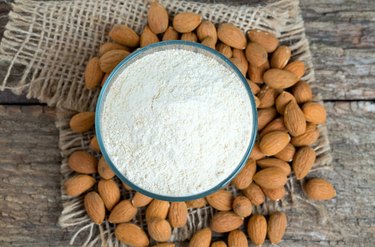
Going low-carb when you love to bake can be a drag. Alternative flours don't seem to work like good old wheat flour. It takes getting used to different flavors and textures, but learning how to use these flours correctly can improve your baked goods so they are more like the originals you love.
Baking With Alternative Flours
Video of the Day
No matter your reason for trading in traditional wheat flour for a substitute, you're in for a surprise. Different textures and flavors — and a pop of nutrition — are the rewards you'll reap for trying something new.
Video of the Day
But you can't just take your grandma's bread recipe and swap out the white flour for rice flour. You won't get a good result, and grandma won't be happy. In many cases, you can't make a 100 percent swap without losing a lot of the integrity of the original product. In other cases, a 100 percent switcharoo might work for one baked good — such as a rustic bread — but not for another — like a sponge cake.
A foolproof way to get a delicious result is to bake with a recipe that was specifically developed for the alternative flour you're using. Baking is finicky, and there's no guarantee with any recipe you use, but you're much more likely to get a good result if you use a tried and tested recipe. Plus, then you don't have to do a lot of unnecessary math.
Baking With Almond Flour
With its low carb content — four grams of net carbs per quarter cup, according to the USDA — almond flour is the darling of the paleo/keto world. You might be confused when shopping for almond flour because of the distinction on packaging between almond flour and almond meal. They are very similar, except that almond meal tends to be coarser and usually includes the almond skins.
But they can be used interchangeably in most cases, although your recipe may call for one or the other. It may also call for super fine almond flour. It's pretty simple to distinguish when you should use almond meal versus almond flour. For a lighter, more delicate preparation, such as a macaron or an airy cake, use a finer almond flour. For more rustic recipes, such as quick breads, tart crusts and cookies, either will work.
However, you have to consider your texture preferences. Almonds are high in fat, so your baked good will be more tender than with a less fatty flour. This is great for pancakes, but not necessarily for crusty breads.
King Arthur Flour recommends using just one-third cup almond flour for every cup of wheat flour in yeast doughs for breads, rolls and pizza, and substituting no more than 25 percent of the wheat flour in non-yeasted cookies, cakes, scones, muffins and biscuits.
Baking With Coconut Flour
Coconut flour is another popular choice for low-carb diets, with 2 grams of net carbs per tablespoon, according to USDA data. It's made from the meat of the coconut after most of the oil has been extracted. It's then dried and ground.
As you would expect, coconut flour has a mildly sweet flavor, which might make it a better choice for cookies, cakes and pies, but not so much for pizza dough (although plenty of people use it for that.)
You can use one-fourth to one-third cup of almond flour in place of regular flour, according to Bob's Red Mill. However, coconut flour can be temperamental, so you definitely want to try using coconut flour for the first time with a bonafide recipe.
It's also very rich in fiber, which is great for your health, but it can absorb a lot of liquid and result in a dry bake — so don't leave any of the wet ingredients out of your recipe. If you're not using a tested recipe, Bob's Red Mill suggests adding an extra egg for moisture. The dough will be thicker than you're used to, but that's normal.
Read more: 5 of the Best Low-Carb Lasagna Recipes
Baking With Rice Flour
You're probably used to seeing rice crackers and rice pancakes — flat things. But you'll be pleased to know that rice flour can also be used to bake in 3D. Brownies, muffins and cinnamon buns are a few of your choices. Rice flour can be used to substitute greater amounts of regular flour than almond and coconut flours, and in many recipes, it can be used alone or in combination with other alternative flours.
Just like wheat flour, there is a white and a whole-grain version of rice flour. White rice flour is like white flour — the rice grain has been refined to remove a lot of the fiber, so it has a finer, softer consistency.
Brown rice flour is made from the whole grain — like whole wheat flour. It retains the fiber and usually has a coarser texture than white rice flour. Brown rice has a slightly nutty flavor, while white rice has a more neutral flavor.
The biggest difference is in nutrition. Brown rice has more protein, fiber, vitamins and minerals than white rice. Making baked goods with a more nutritious flour is a definite bonus for your health, so why not give it a try?
- USDA: "Almond Flour"
- Kitchn: "7 Ways to Bake with Almond Flour and Almond Meal"
- King Arthur Flour: "Baking With Almond Flour"
- USDA: "Coconut Flour"
- The Vegetarian Resource Group: "Cooking with Coconut Flour and Coconut Sugar"
- Bob's Red Mill: "8 Tried and True Coconut Flour Recipes"
- Bob's Red Mill: "Baking with Alternative Flours"
- Bob's Red Mill: "Brown Rice Flour"
- Bon Appetit: "Flour Power: Your Definitive Guide to Baking With White, Wheat, and More"
- Bob's Red Mill: "White Rice Flour"